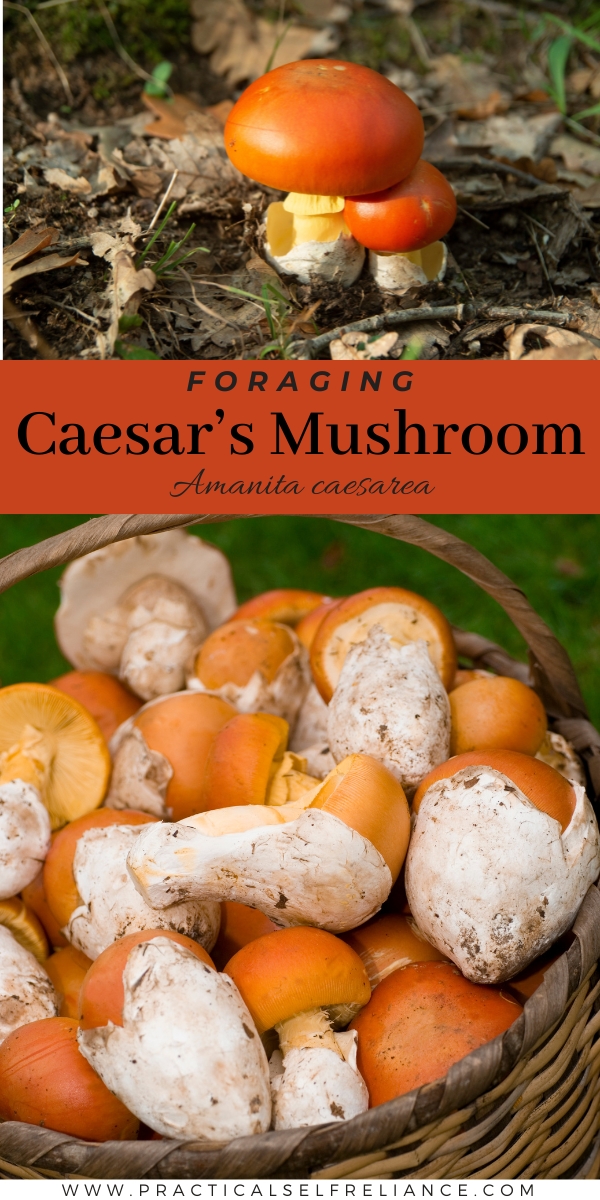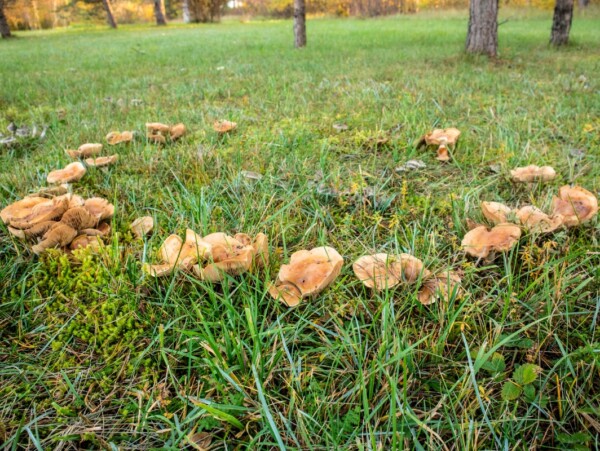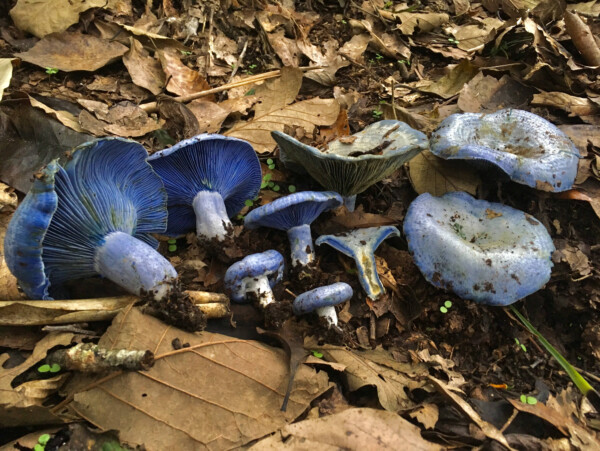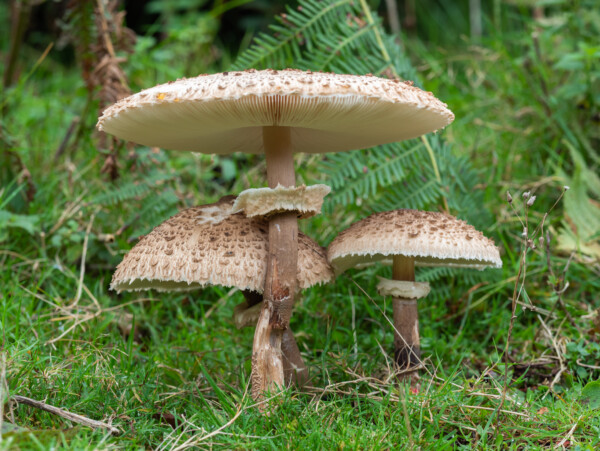Affiliate disclosure: This post may contain affiliate links. Please see our Privacy Policy.
Caesar’s Mushrooms (Amanita caesarea, and other edible amanita species) are a group of choice edible wild mushrooms, but they can be difficult to identify. While this mushroom isn’t for beginners, it’s still a fun one to find in the woods!
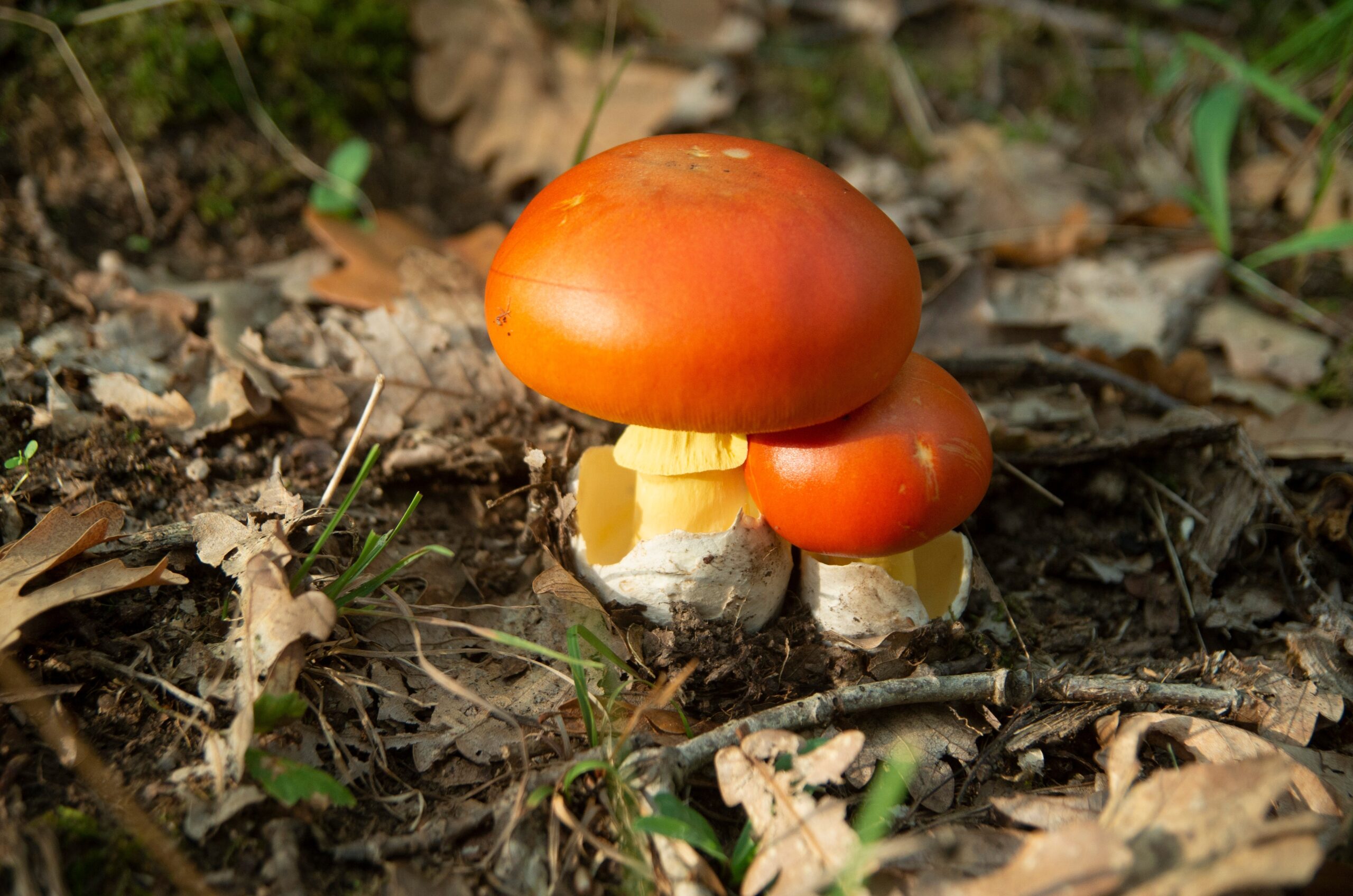
This article was written by Timo Mendez, a freelance writer and amateur mycologist who has foraged wild mushrooms all over the world.
Caesar Mushrooms are some of the most adored and loved wild mushrooms on the planet and it´s no surprise why; everything about them is exquisite. Their flavor, their texture, and their outstanding color all make them a scrumptious delicacy. In my honest opinion, it is mushroom unrivaled by most others.
Don´t get me wrong, I love a lot of different wild mushrooms and have eaten well over a hundred different species, but this one is up there on the list of the most delicious.

It´s not just me who loves them either. Almost anywhere they grow, they are adored by mushroom enthusiasts who scour the woods looking for them.
The name itself is an omen to the Roman rulers who adored this mushroom and would serve them in luxurious banquets as a means to show off their wealth.
To this day, a single kilogram can reach prices of over 100 dollars in European markets.
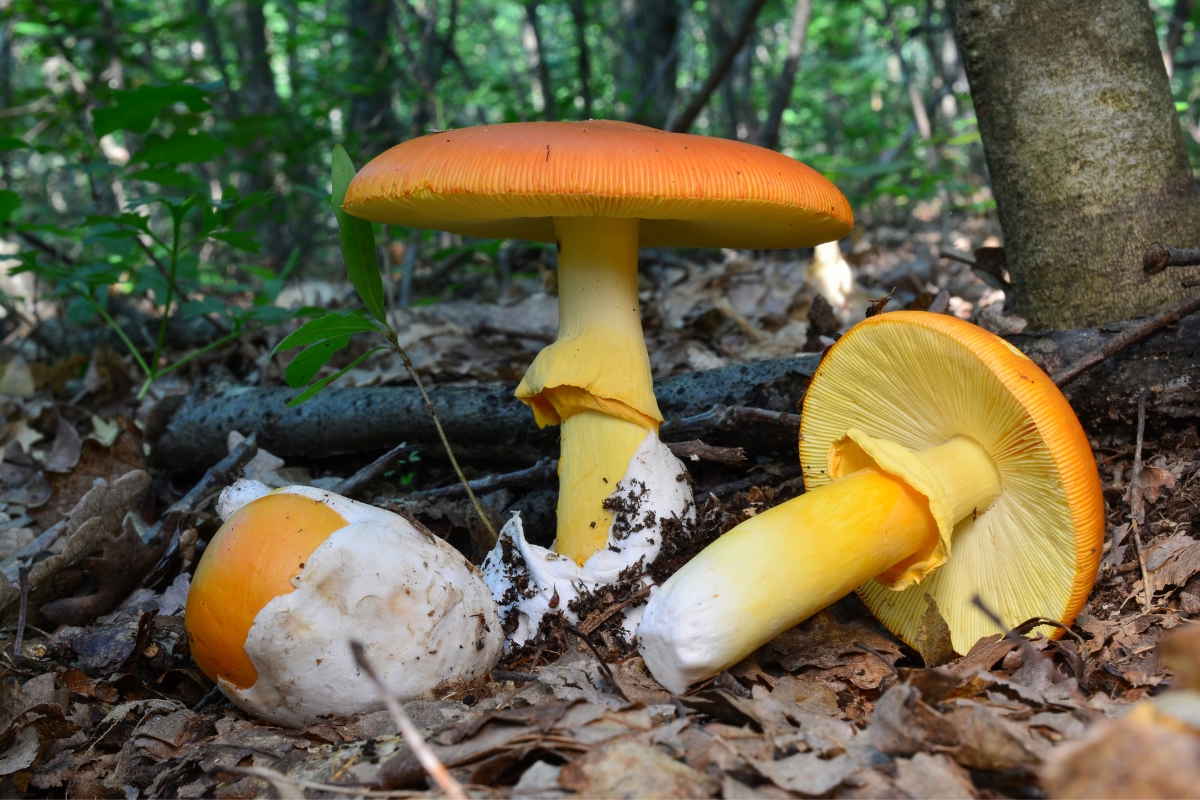
Yet, in some ways, this mushroom is a two-sided coin. After all, it´s related to the most infamous toxic mushrooms out there. This includes the deadly Amanita phalloides and the toxic Amanita muscaria, both of which are responsible for countless mushroom intoxications.
Amanita phalloides is responsible for more mushroom-related deaths than any other mushroom. Legend has it, that emperor Claudius Caesar was murdered using these mushrooms as they were discreetly fed to him in place of the Caesar’s Mushroom he so cherished.
The resemblance of this mushroom to other toxic species means it needs to be picked with the utmost care. For this reason, I always recommend amateur foragers to abstain from this mushroom, and any edible Amanita for that matter, until they´ve got a firm grasp on identifying mushrooms. While you can learn it within a season, especially if you have guidance from an experienced forager, it´s not usually one you want to start your foraging career with.
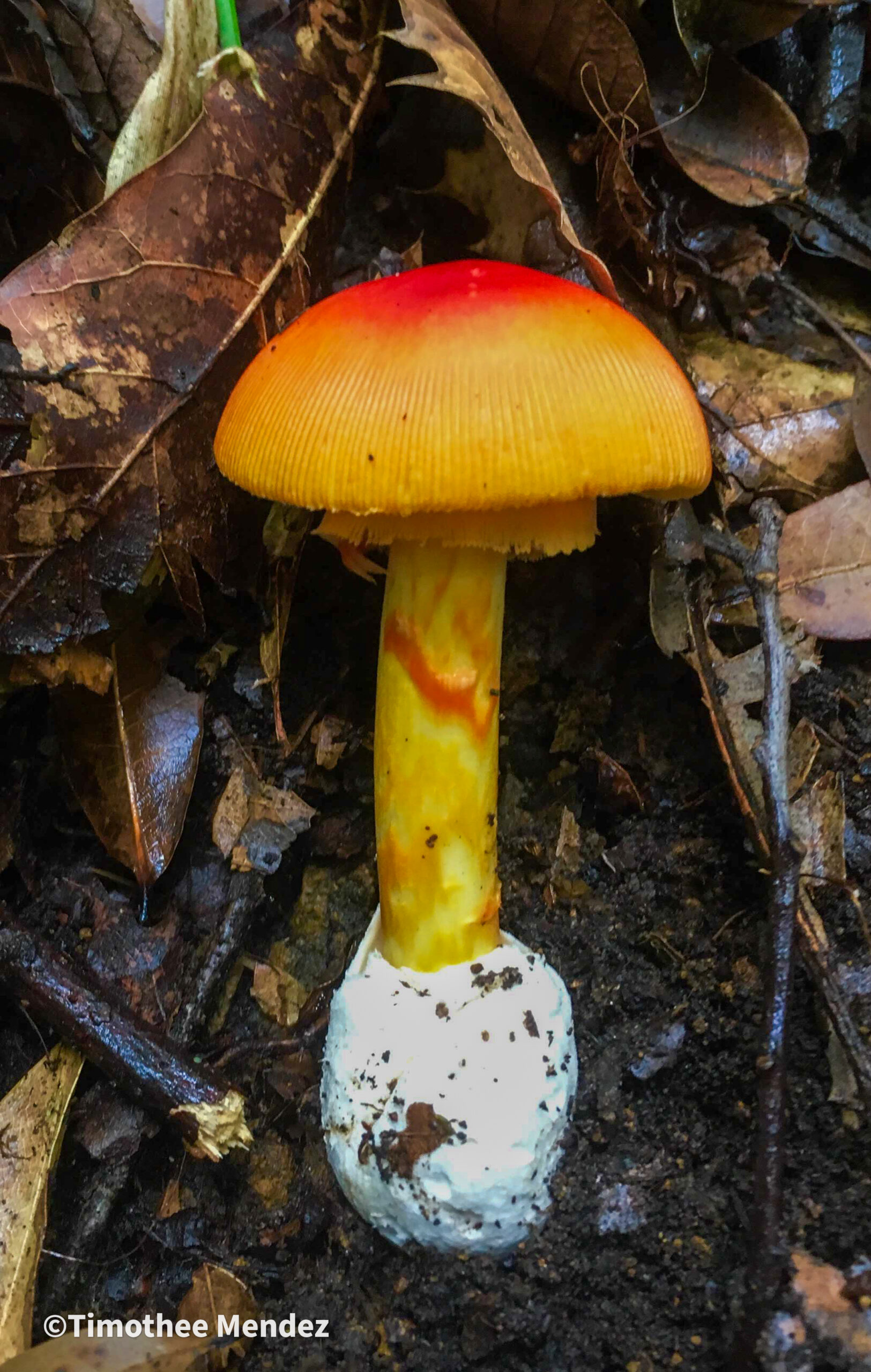
Natural History Of Caesars Mushroom
There are more than a dozen species of Caesars Mushroom worldwide. They can be found in North America, Europe, and Asia, each bioregion having its unique species. In North America, there are more than five species with a distribution restricted to Mexico plus the eastern United States and Canada. The most common of these is Amanita jacksonii. Europe has a single species, the original Amanita caesarea, which is largely distributed in the Mediterranean but its distribution is moving northward.
The western United States and Canada do not have any Caesars Mushrooms. This being said they do have two other Amanitas in a closely related group. These are the Spring Coccora (Amanita vernicoccora) and the Fall Coccora (Amanita calyptoderma). While these are reserved for advanced foragers, they´re worthwhile edibles and comparable to Caesar Mushrooms. I won´t be discussing these in this text though.
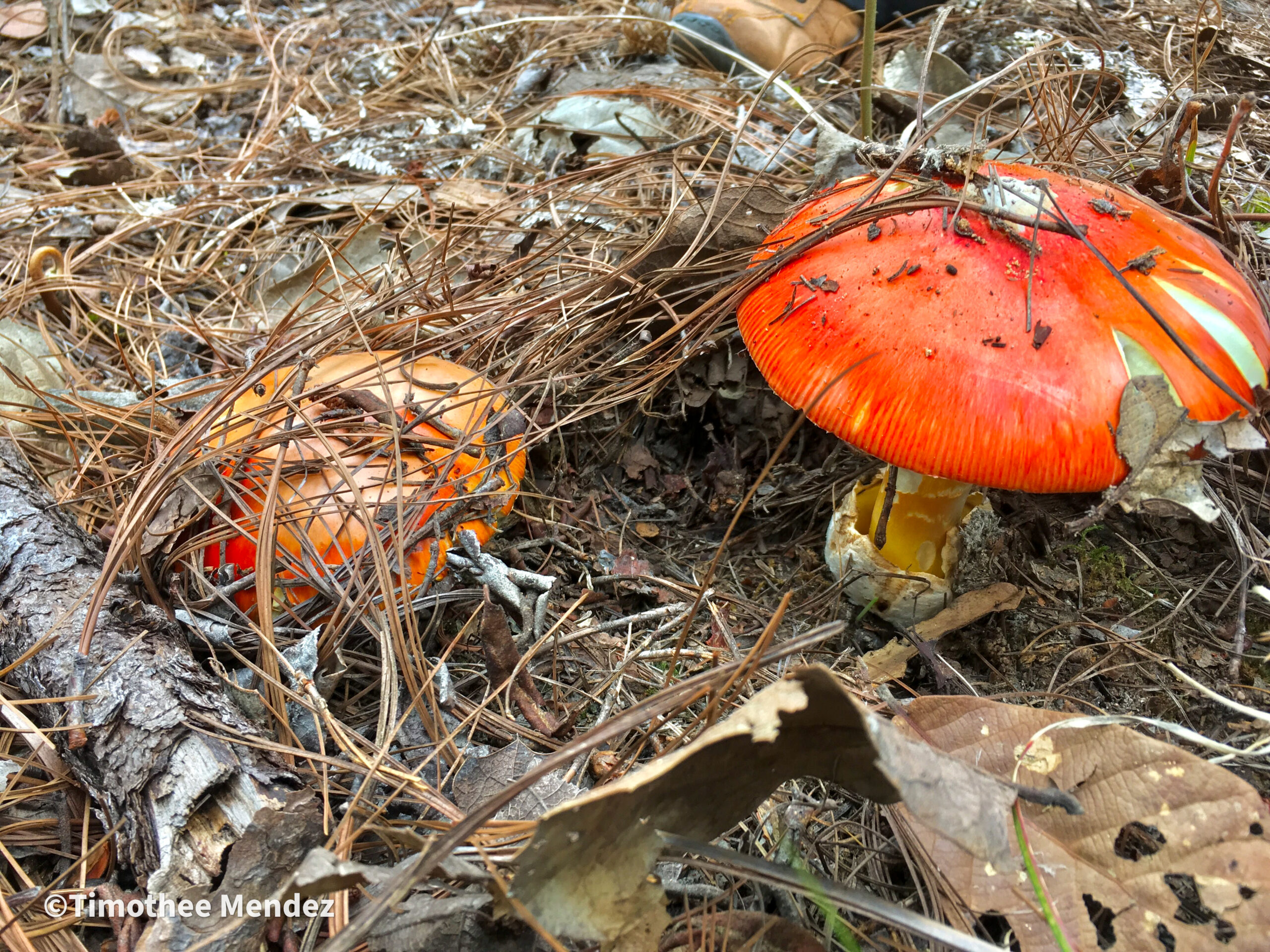
The exact taxonomy of Caesar Mushrooms is still being worked out and there are still many undescribed species in North America. Below there is a list of species within the Caesars Mushroom Complex, all of which are considered edible. For clarification, this is different than the classification Amanita section Caesareae which likely includes upwards of 100 species not all of which are known to be edible.
Species of Caesars Mushrooms Complex
- Jackson´s Slender Caesar (Amanita jacksonii)
- Caesar´s Mushroom (Amanita caesarea)
- Bas´ Caesar (Amanita basii)
- Arkansas Caesar (Amanita arkansana)
- Laura´s Caesar (Amanita laurae)
- Asian Vermillion Slender Caesar (Amanita caesareoides)
- Yolk-Colored Caesar (Amanita yema)
- Half-Dyed Slender Caesar (Amanita hemibapha)
- Mayan Slender Caesar (Amanita hayalyuy)
- Javan Slender Caesar (Amanita javanica)
- Amanita malayensis
- Boedjin´s Slender Caesar (Amanita simillis)
For this text, I simply use the term Caesar´s Mushroom in reference to all of these species. While each is distinct, they are, for the most part, very similar mushrooms, and distinguishing between some of them can be difficult. Many old North American field guides classified all these species under the name Amanita caesarea. The good news is, that you don´t need to identify the exact species to make sure it´s edible, just that it falls into the group.
Caesars Mushrooms are ectomycorrhizal fungi, meaning they only grow in association with certain tree species. Ectomycorrhizal fungi obtain all their energy from their hosts, and in exchange provide them with soil nutrients and other ecological services. This is why Caesar mushrooms, and many other wild mushrooms, cannot be cultivated using conventional methods. The main host trees for Caesars Mushrooms include Oak and Pine.
Caesar mushrooms are considered thermophilic, meaning they fruit in warmer temperatures and generally prefer mild to warm climates. For this reason, they are most abundant with summer rains at the beginning of the mushroom season.
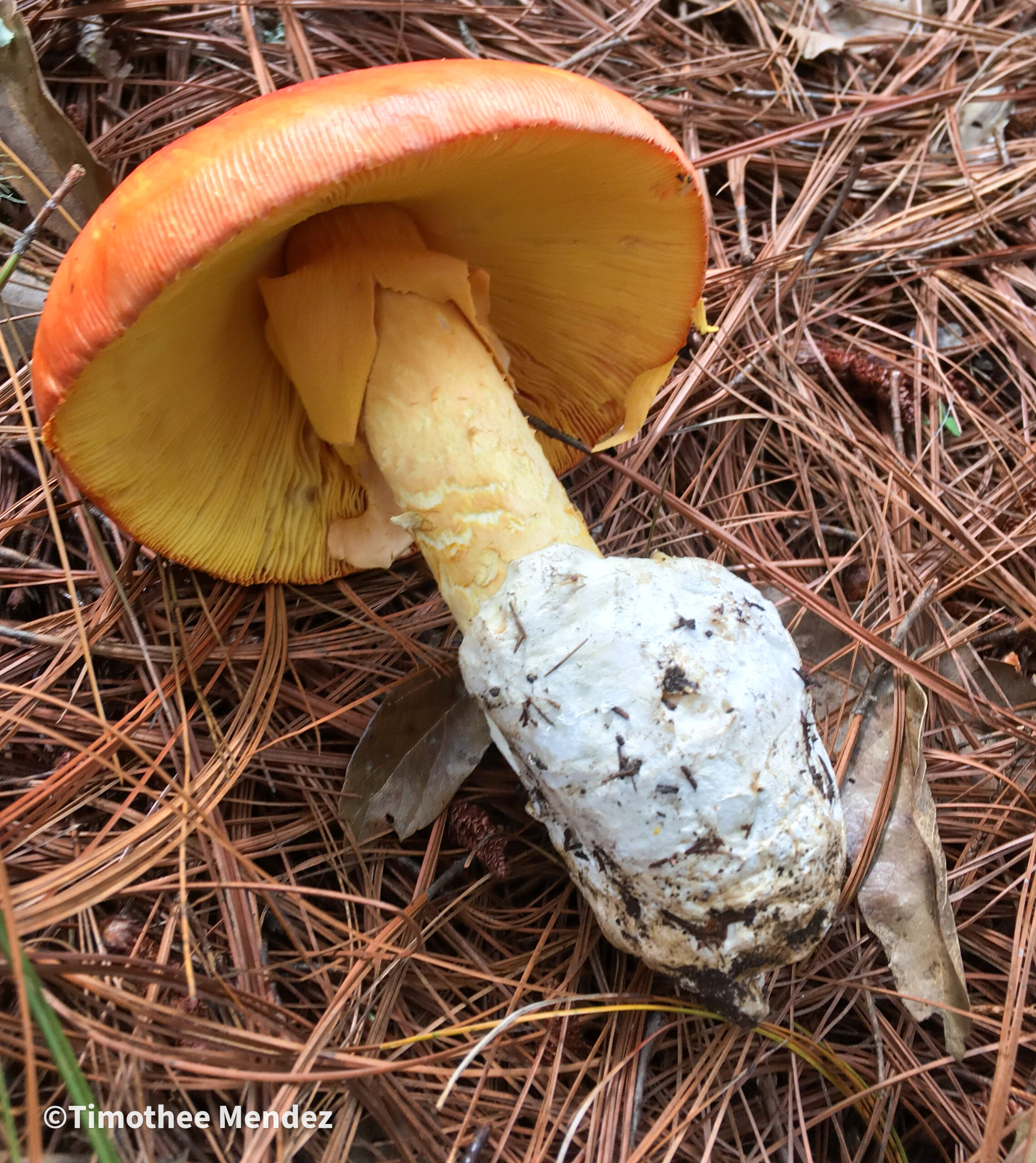
Where To Find Caesars Mushroom
Caesar mushrooms are widespread in the eastern United States and Canada. They occur from the Gulf states up to Nova Scotia and Quebec. They can´t be found in the western US or Canada, nor the Rocky Mountains or the Great Plains. They’re also absent or rare in southern Florida. In the Midwest, they’re relatively rare but there is a yellow variant that occurs in Oak forests. They are widespread in the montane temperate forests of Mexico and also occur in the Sky Islands of Arizona.
In Europe, Caesars Mushrooms thrive in areas with warm climates typically in southern latitudes. This includes Portugal, Spain, southern France, Italy, Greece, Serbia and Croatia. They’ve been found as far north as Germany, but it’s highly unusual.
Regarding the habitat, Caesar’s mushrooms grow in association with Oak and in some cases Pine. It’s not uncommon to see them fruiting on forest edges or exposed locations that likely have warmer soil temperatures. When there is enough moisture, they’ll happily fruit in a grassland on the edge of a forest. All this being said, they can also fruit within a closed and shady forest and even below bushes. In North America, they tend to frequent a lot of the same woods where you find Lactarius indigo.
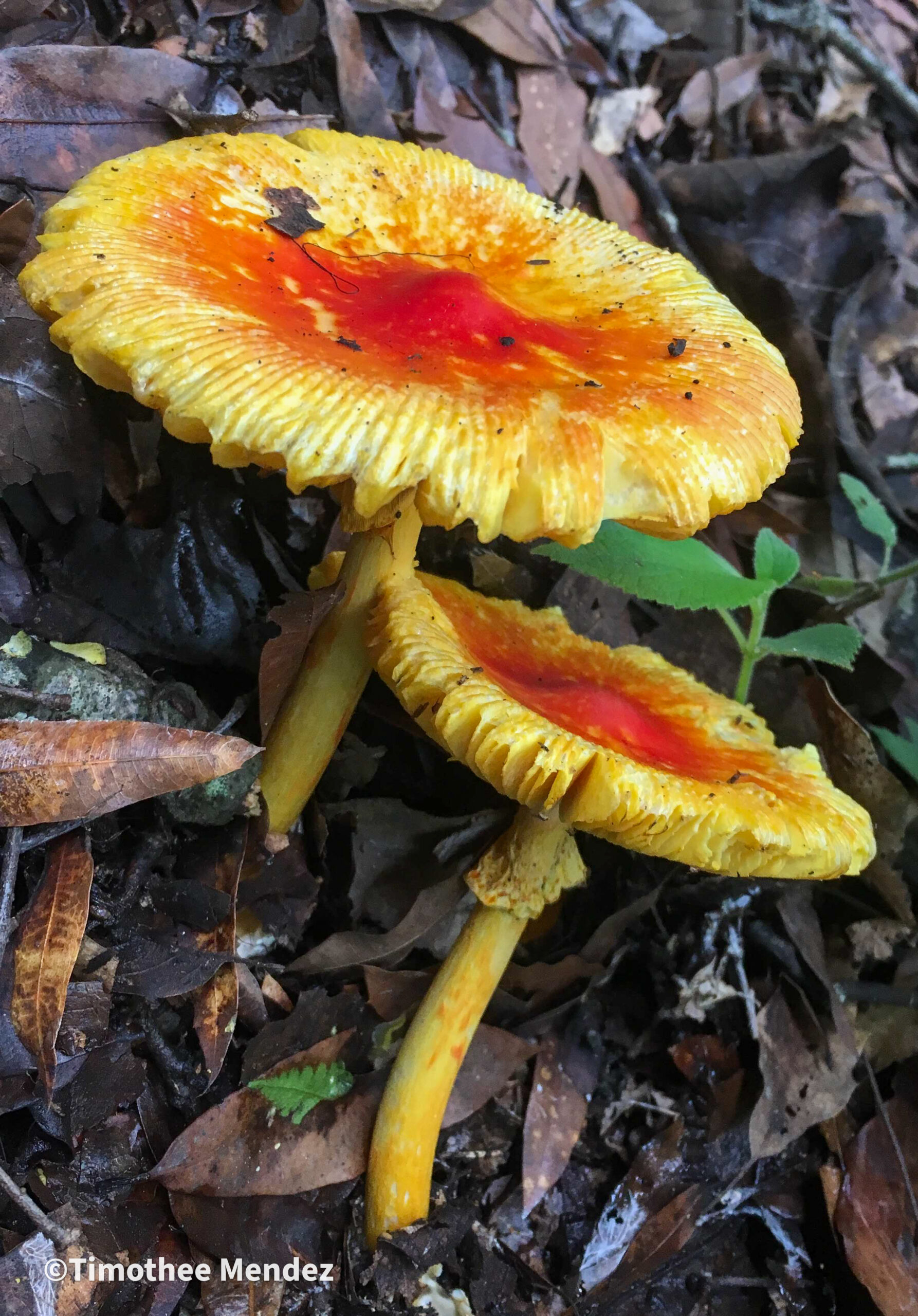
When Is Caesar Mushroom Season
Northeastern United States and Canada (June to August): The season starts in June and usually peaks around mid-July. It declines throughout August and ends somewhere in September.
Southeastern United States (June to October): In the south, the season typically starts a bit sooner than in the north as temperatures warm up. The soonest you’ll see them is generally around May. The season peaks around August and then declines until its end in September.
Gulf States (May to August): The Gulf states have a pretty long season ranging from May to November. Their peak production is typically in June, followed by a decline during August when there is often 2-3 weeks of dry weather. In early fall there is typically a second flush that occurs in the Gulf States.
Arizona Sky Islands (July to September): The season in the Sky Islands is short and peaks in August.
How To Identify Caesars Mushrooms
Caesars Mushrooms are pretty straightforward to identify as long as you pay attention to some key details.
The first thing you´ll notice about them is that they have a brilliant orange-to-red cap. This is especially true for Amanita jacksonii which is a marvelous red color. The midwestern varieties are a bit more yellow, while the Sky Island species tends to be browner in color. Often this color can easily be observed from a distance. On some specimens, the center of the cap tends to be slightly darker and fades to a lighter tone towards the margin.

When young, the cap is oval and opens up like an umbrella as it matures. As the cap opens up the color also tends to turn lighter in color. Caesars Mushrooms also have a distinct striated margin, meaning there are little indented lines along the entire edge of the cap. The cap surface should not have any white warts or patches as would be the case in certain amanitas.
The second thing you’ll notice is the sheer size of the mushroom. These tend to be relatively large and chunky mushrooms. They can grow to be 10 inches (24 cm) in height with caps that reach 5 inches (12 cm) across. While you shouldn’t rely on size alone as an identification feature, it is typically a quick way to tell it apart from some smaller dainty lookalikes.
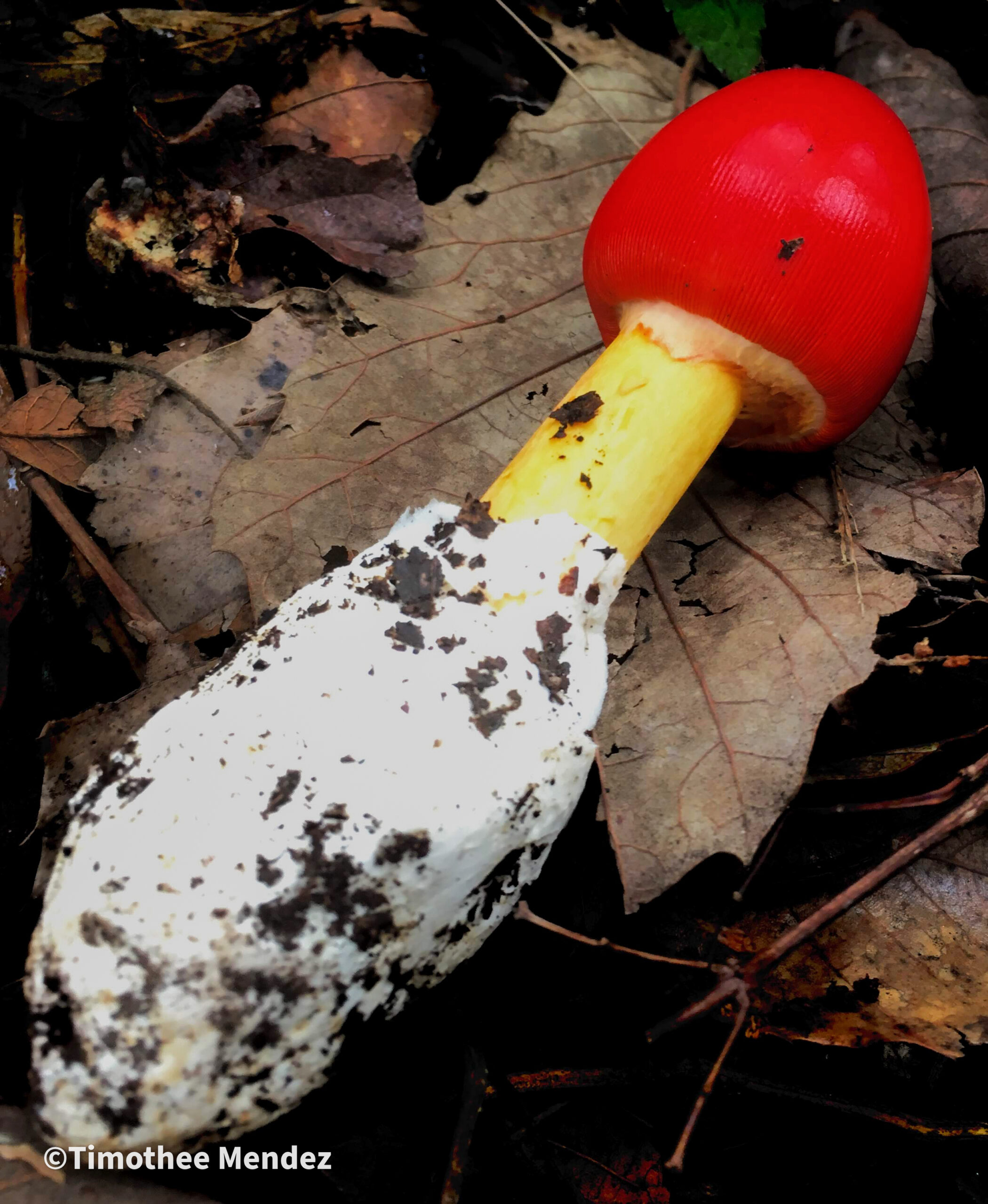
One of the key features that distinguishes this species is the yellow-orange tone of the stem, gills, and skirt. In some specimens, the skirt and the upper part of the stem are very orange while in others it is more yellow. If you don’t see this tone and instead see a white color, you have a lookalike. Keep in mind that some lookalikes like Amanita flavoconia and its relatives also bear this coloring, so it is not considered a diagnostic feature. The stem also often has silky fibers on its surface.
One of the last important features of this mushroom is it grows from a sack-like egg called a volva. While all Amanitas have volvas, the ones on Ceasar’s mushrooms are particularly cottony and open up like a sack. Other Amanitas have the volva closed and attached to the stem. While the volva is often easily visible, you may need to carefully dig the mushroom out with its base to get a good view at it.
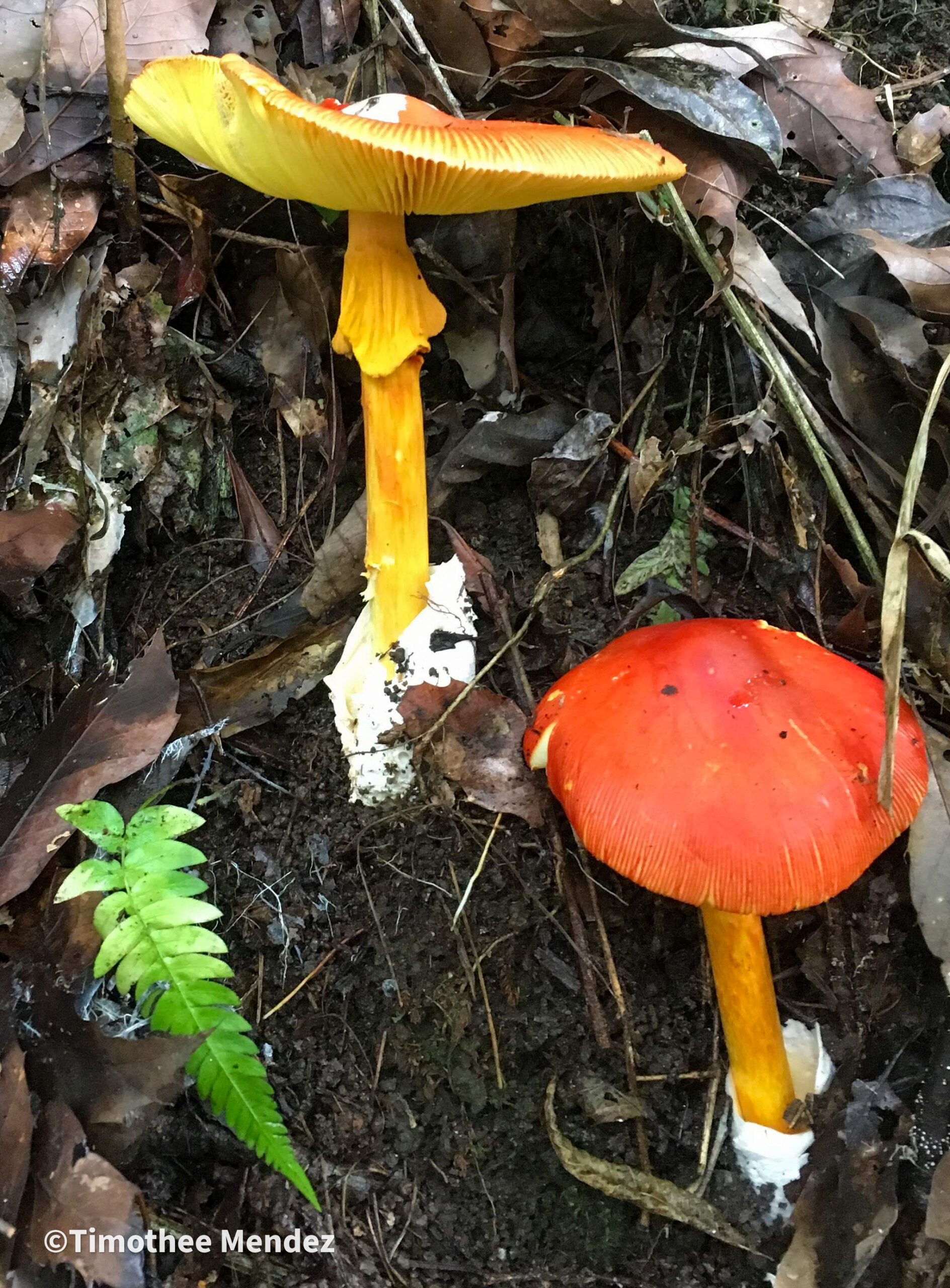
Finally, I just want to mention that since there are many species of Caesars Mushrooms the exact tones/features present on all parts of the mushrooms vary. I recommend only picking those with very distinctive features that leave no doubt about their identity. For this mushroom, there is no single diagnostic feature, but it is a combination of many that is necessary to properly identify. Always know your lookalikes!
Identification Features of Ceasars Amanita
- Brilliant orange to red cap that can be up to 5 inches across. Color may be darker in the center and fade towards the margins.
- The cap starts oval-shaped and opens up to become convex.
- The cap has a well-defined striated margin.
- No white warts or patches on the cap surface. Check this carefully to make sure they haven’t just been washed off by rain.
- Relatively large mushroom, reaching up to 10 inches in height.
- The yellow-orange tone in the stem, gills, and skirt. The skirt and the upper part of the stem have a distinct orange color.
- Grows from a large cottony volva that is sack-like.
- No distinct odor
- Spores are white
Caesars Mushroom Lookalikes
Knowing lookalikes is crucial if you want to learn to pick this mushroom. Don’t be afraid to handle the potential lookalikes when you´re in the field so you can take a better look at them. Remember, you can’t get poisoned just by touching the mushroom.
The Death Cap (Amanita Phalloides)
This is the deadly one you’re going to want to be most careful of. This species causes the most mushroom-related deaths in the world, so it’s a good one to know and stay away from. While it is native to Europe, this species has been introduced into the United States and Canada.
The most distinctive thing about this species you’ll notice first is the olive-colored cap. It can be a bit greenish, yellowish, or even light brown in some specimens. It´s not a particularly attractive color to tell you the truth. This should quickly tell you it is not a Caesars Mushroom which features bright red-orange coloring on its cap surface. Also, the death cap does not have striations around the margin as Caesars Mushroom does.
The second thing you’ll want to observe is the color of the gills. In the Death Cap, the gills are a plain-white color and do not have the yellow-orange tones that the Caesars mushrooms have. This is also true for the upper part of the stem. The lower part of the stem may have yellowish tones, but not orange.
The rest of the mushroom, including its shape, size, and volva are all pretty similar. The biggest differences as mentioned before are the olive cap color, the lack of striations on the cap margin, and the white-colored gills. If your mushroom has any of these features, avoid it.
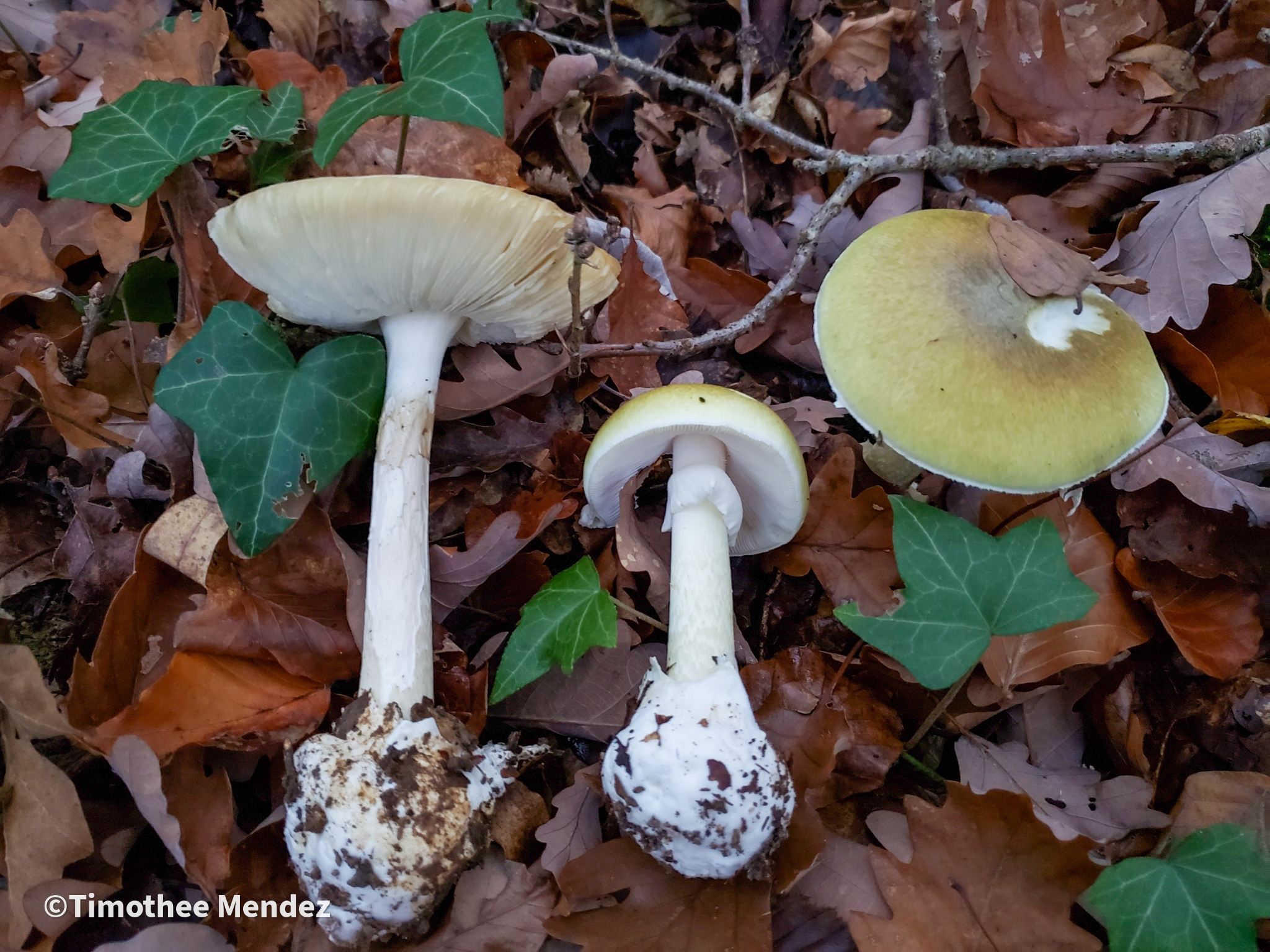
The Fly Agaric (Amanita muscaria)
Amanita muscaria or the Fly Agaric, is one of the most iconic mushrooms on the planet. It´s the Christmas-themed species featured in Mario or Alice and Wonderland. While most people recognize what mushroom I´m talking about, it is pretty easy to mistake it for Caesar mushroom in certain situations. After all, North American varieties of Amanita muscaria can have orange-yellow tones, just like Caesar’s Mushroom.
While it’s not considered deadly, it could be an extremely unpleasant experience if you eat this mushroom by mistake. Intoxications can result in diarrhea, hallucinations, dizziness, sweating, disorientation, vomiting, nausea, and in some cases, long-term health impacts. To say the least, it’s not fun.
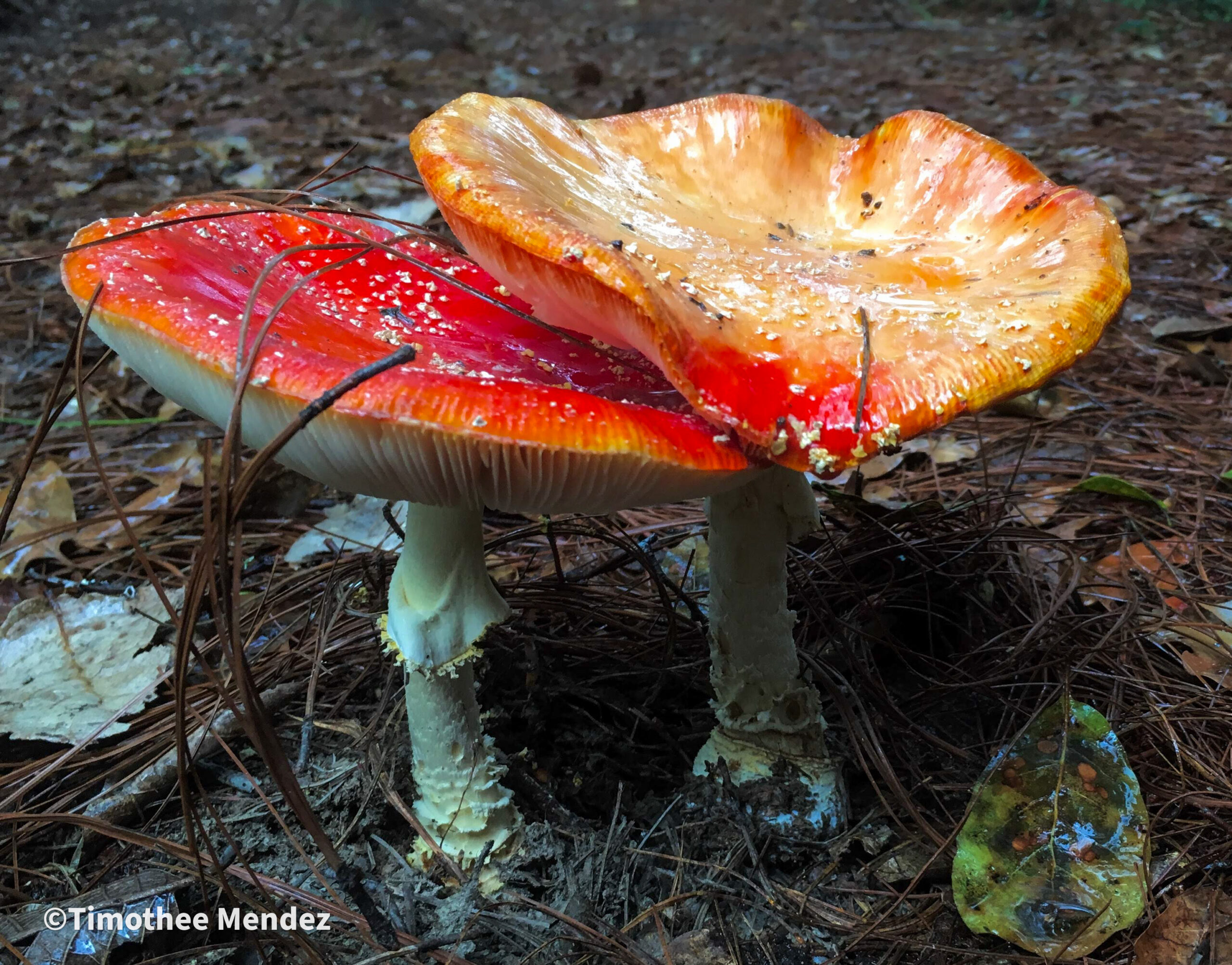
Just in case there are any taxonomy nit-pickers out there, I want to clarify that this is also a complex of many closely related species. The classic Amanita muscaria is only native to Europe and the North American varieties go by all sorts of proposed names and varieties. There´s no need to go into the taxonomy here though.
The quickest way to differentiate Fly Agaric from Caesars Mushrooms is by the small white or yellowish warts on the cap. These are known as ¨veil remnants” and are leftover parts of the universal veil that covered the entire mushroom when it was young. Sometimes these warts are evenly distributed on the cap surface, but other times they may be patchy.
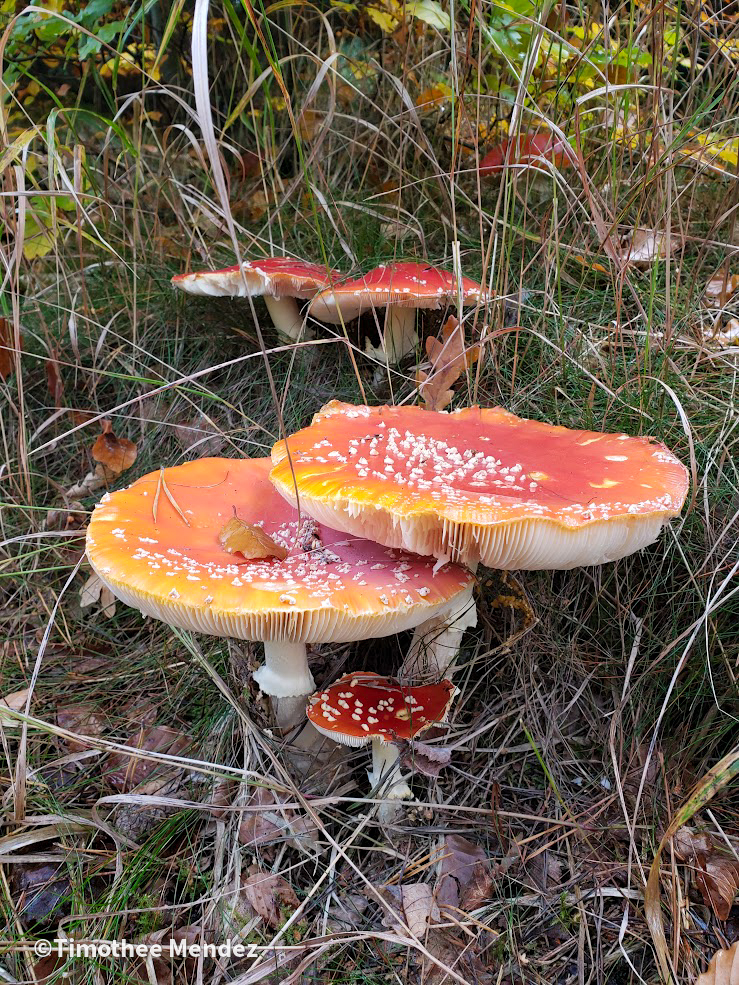
Just be careful because when these mushrooms experience a lot of rain, it can wash away the warts leaving a smooth surface like that of Caesars mushrooms. For this reason, pay close attention to any warts or patchy white tissues that may be left behind on the cap or its margin. Sometimes it can be subtle.
Don´t solely rely on the lack of warts to confirm it’s not a Fly Agaric though. Amanita muscaria also has white gills and a more compact volva. The stem on Fly Agaric is usually also white, although it can have yellowish tones to it.
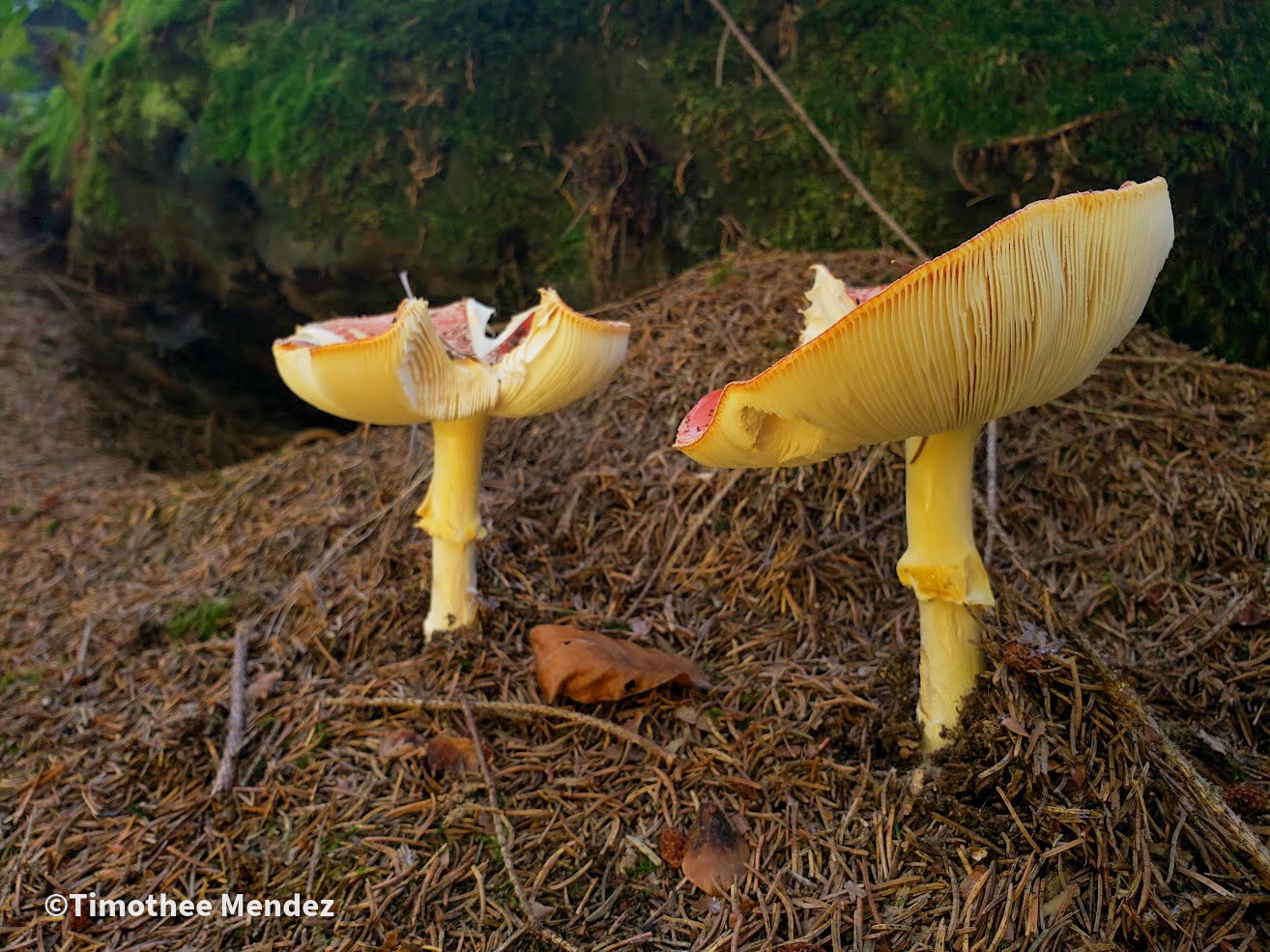
Yellow Patches (Amanita flavoconia)
These mushrooms are a bit of an intermediary between Fly Agarics and Caesar mushrooms. While these are often considered toxic, many mycologists don’t consider them very dangerous, although it’s best not to experiment. There are a handful of species closely related to Amanita flavoconia that also make up a complex.
Like the Fly Agaric, these mushrooms typically have warts or patches on the cap surface. These can also get washed off sometimes like the Fly Agaric, so pay close attention. These mushrooms also don’t usually have defined striations on the margin, although they can have subtle ones.
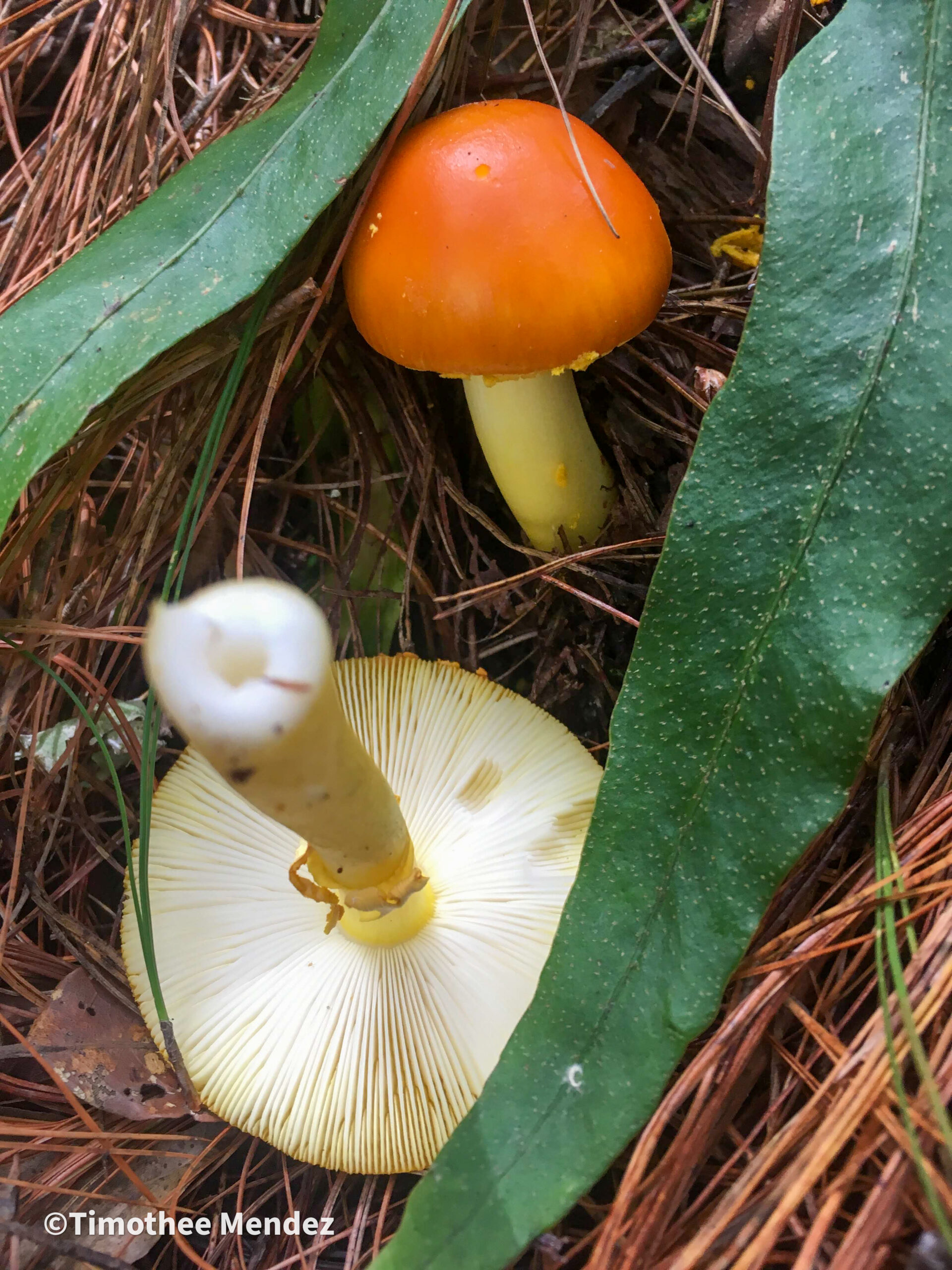
What makes these mushrooms a bit more difficult, is that they often have a yellow-colored stem and skirt like Caesars do. While the gills are often white, some varieties even have yellow-colored gills. This coloring can make them resemble a Caesar’s Mushroom.
The sure way to differentiate this one is that it has a small, closed, and often spherical volva. It does not have the showy sac-like volva that Caesar mushrooms do. Sometimes the volva on Amanita flavoconia is faint, appearing as though the stem base is just a bit swollen. This characteristic is key to differentiating this mushroom. These mushrooms also tend to be smaller, daintier, and more slender than Caesar mushrooms.

Final Word Of Caution
Be very careful when picking Caesars Amanita. Always double-check your findings, and ideally seek consultation from your local expert. It doesn’t hurt or take much effort to take a few good pictures and send them off to someone you trust with identification. There are many deadly or highly toxic lookalikes, so always pick these with utmost caution!
How To Forage Caesars Amanita
Like I always mention, forage with respect. Tread lightly, avoid causing erosion, and never litter. Also, be respectful to other people who may frequent the forest or utilize its resources (such as other mushroom pickers).
When they’re around, it’s not too difficult to find Caesars Amanita. They have a bright color and large size, making them hard to miss. You can usually see this mushroom from a distance, especially if the patch has 4 or 5 mushrooms in it. For this reason, it often works to just scan a wide area of the forest while walking on an easy-to-navigate trail.
Once you find a mushroom, you should approach it to verify your find. Look for all the features listed in the identification section of this text. This includes a large sac-like volva, smooth orange-red cap, yellow-orange gills, and a striated margin. If you have any doubts about your find you can take plenty of photographs in the field to verify with an expert.
You can also take the mushroom with you, but it’s good to take pictures anyway because diagnostic features can be damaged during transport. If you do decide to take the mushroom with you, make sure not to get it mixed in with your known edibles. While just being in the same basket won’t transmit toxins to the edible species, it happens that people accidentally eat the toxic ones this way.
Once you’re sure you have a Caesar mushroom, it’s time to harvest. Some folks like to cut them with a knife near their base, while others prefer to just pick them. Many experienced mycologists prefer to pluck the mushroom from below using a knife, to have it plop out with its entire volva. This latter method of harvesting is reccomended to make a scientific collection for proper identification.
Really, you can just harvest in whatever way you prefer or that which is accepted by the local community. I know many people believe it is best to cut the mushroom, but few scientific studies have been done on this matter and they suggest it makes no difference (Egli, 2006; Norvell, 2016). Many experts I know suggest picking the entire mushroom is healthier to prevent diseases in the fungal mycellium.
Once picked, you should transport this mushroom carefully. They are pretty fragile and can easily get beaten up in a basket full of other mushrooms. Wide baskets are excellent for this.
If you need to store these mushrooms fresh, it is best to do it somewhere cool with plenty of air circulation. You can store them in the fridge, just make sure it is in a wide bowl and most importantly don´t forget about them. They should be eaten within 1-2 days after picking.
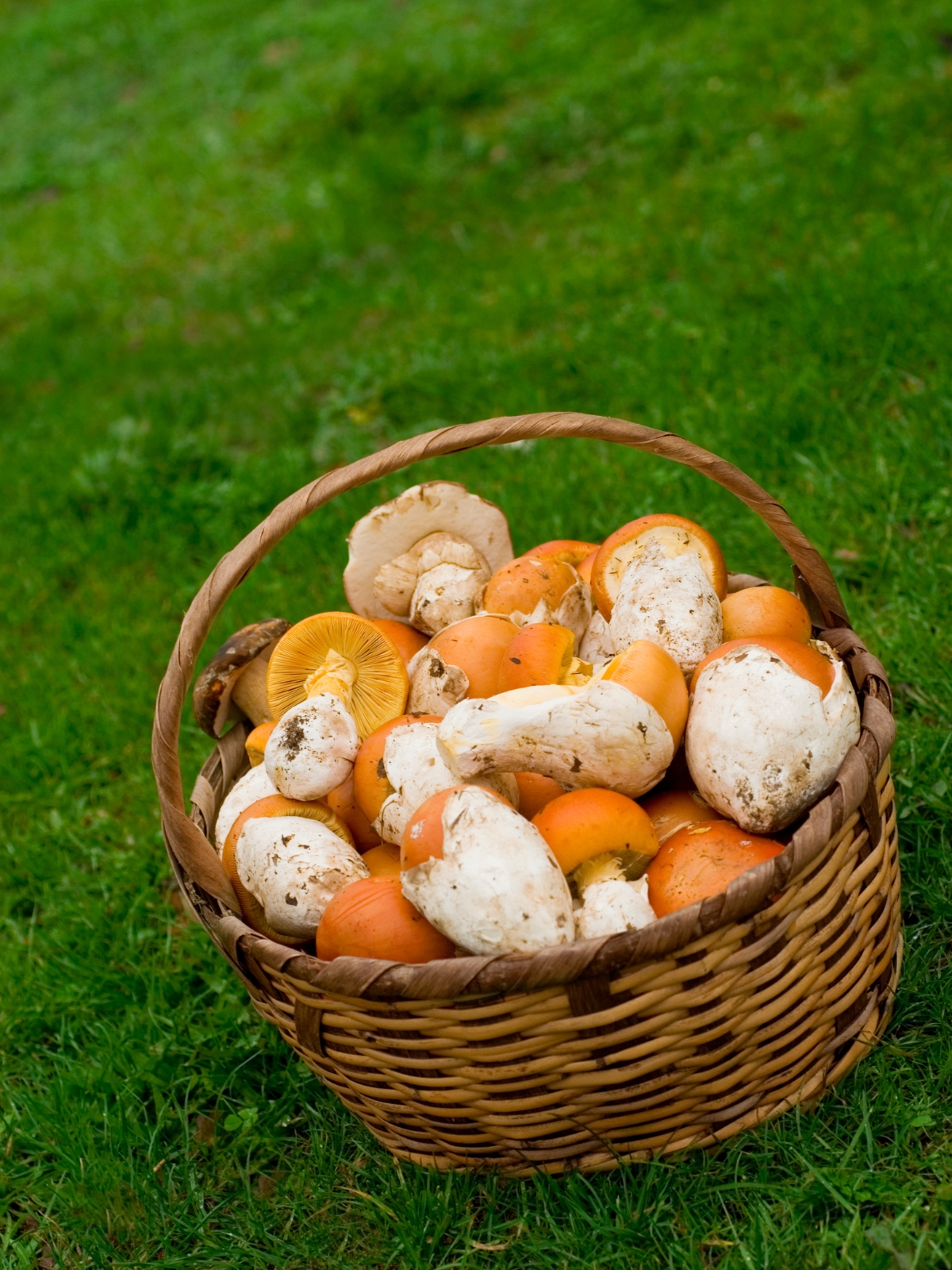
Cooking with Caesars Mushrooms
Caesar’s mushrooms are some of the most delightful mushrooms to eat and cook. They attribute a unique umami flavor, that’s delicious but hard to describe. To me it almost reminds me of chicken broth, but really “mushroomy” and unique.
There are many ways to cook it, but as is often the case with mushrooms, the simpler the better. You can slice it up and fry it with a bit of butter, garlic, and pepper. Wait until the mushroom turns a bit golden-brown on both sides, then take it off the skillet. Top it off with salt and parsley, and accompany it with a sauce and lime. You can also simply prepare it this way and use it to garnish whatever recipe you’d like to make. This could be a soup, pasta, salad, or risotto. You could even put the slices between a burger or a sandwich if that’s what you’re craving.
Honestly, I also find this mushroom to be pretty delicious “a-las-mexicana”. This pretty much means sauteed with onions, peppers, tomatoes, and cilantro. While the flavor is a bit obscured like this, the combination is awesome. Another one of my favorites is to make this in a brothy vegetable soup. For soup, I like to use them dried because it seems to concentrate the flavor substantially.
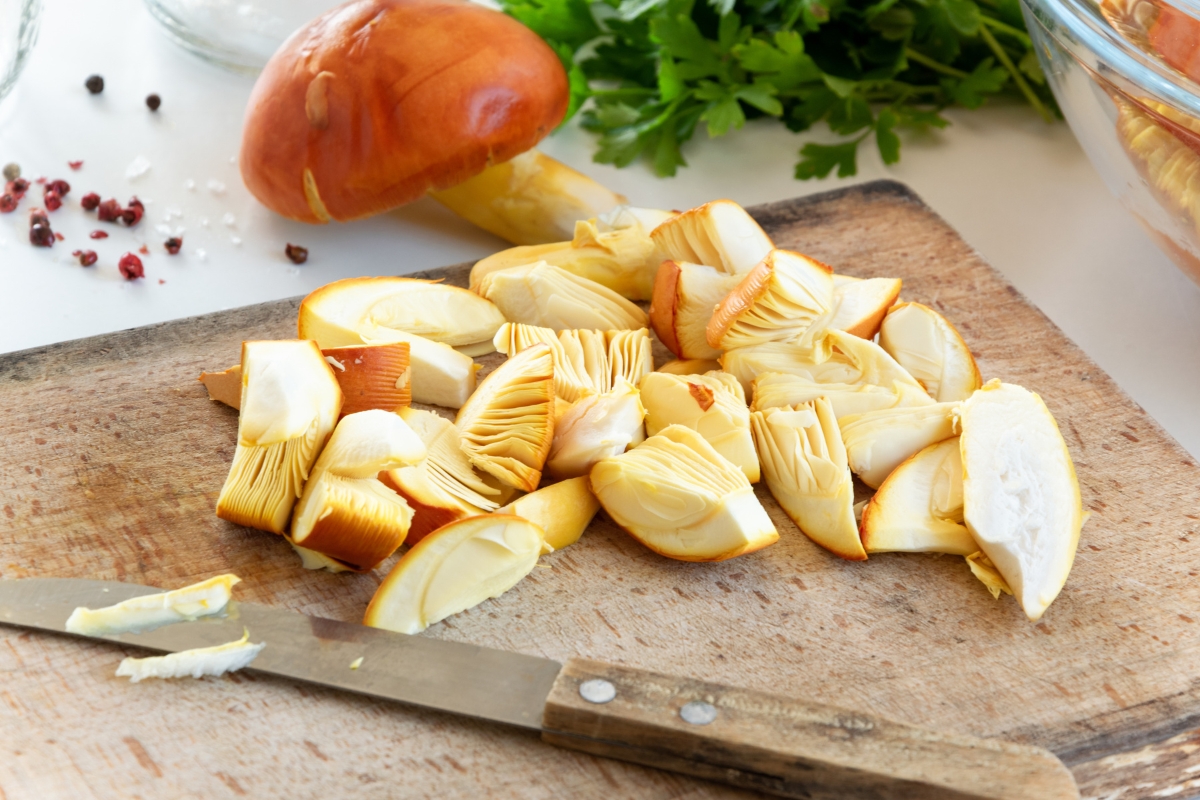
Preserving Caesars Mushrooms
There are 3 main ways to preserve Caesars mushrooms.
Dehydrating: The most common and easiest tends to be dehydrating them. They won’t be the same once rehydrated, but like I mentioned before, the flavor gets substantially intensified when dried. Just make sure they get crispy-cracker dry and store them in an air-tight container. If you live in a moist climate, consume them within 1-2 years max unless you take good precaution that they stay dry.
Pickling: I haven’t made many pickles with this mushroom, but I have tried them before. They retain a good texture and the flavor is well preserved. To do this, simply steam the mushrooms for 5-10 minutes and then place them in your favorite pickling brine. This could be for a lacto-fermented pickle or quick-pickle with vinegar.
Cook and Freeze: The simplest for many folks will be the cook-and-freeze method. Simply cook your mushrooms as you’d like, then place them in your freezer. If you want a neutral taste you can simply steam them, or you can have them preseasoned with seasonings of your choice. Whenever you need them, simply defrost them and heat them up. Don’t ever freeze raw mushrooms as their cell walls will burst and you’ll get a slimy mushroom mess once it defrosts.
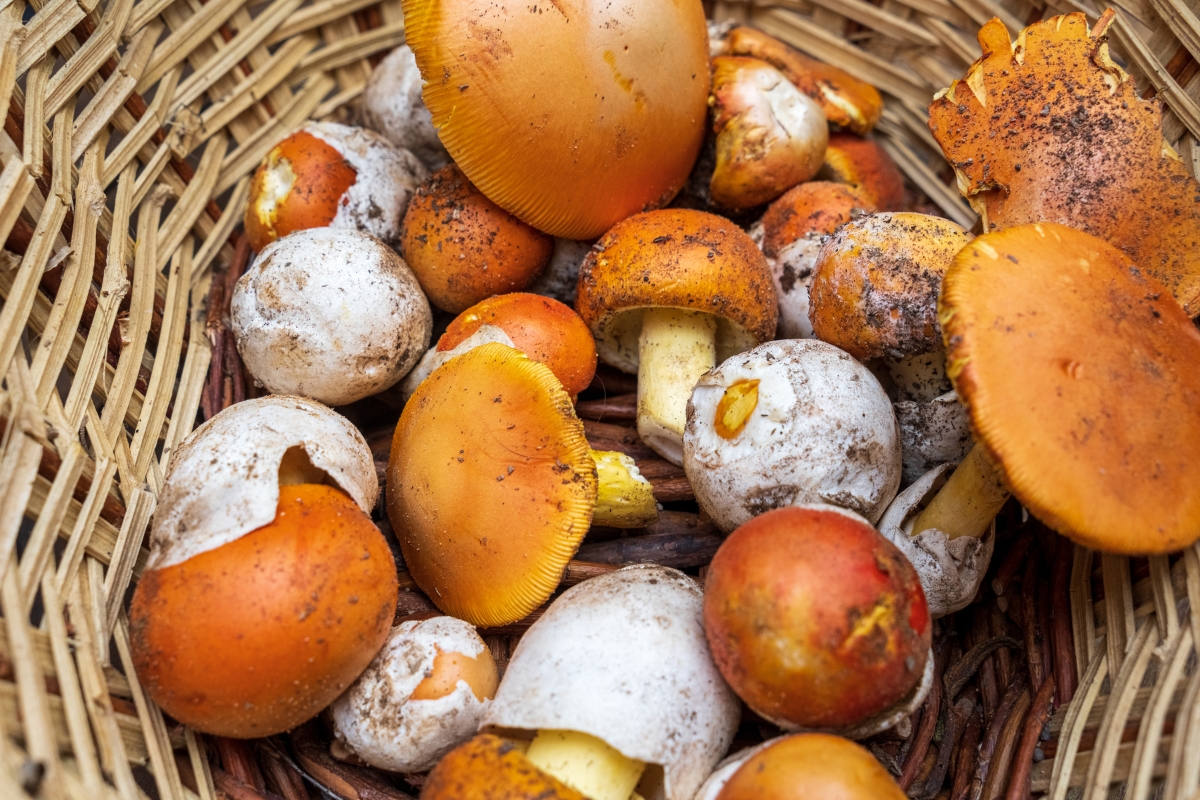
Summer Mushroom Foraging
Looking for more edible wild mushrooms to forage this summer? These summer mushroom identification guides will help keep you busy!
- Puffball Mushrooms
- Shaggy Mane Mushrooms
- Reishi Mushrooms
- Turkey Tail Mushrooms
- Dryad’s Saddle
- Saffron Milk Caps
- Chanterelle Mushrooms
- Pigs Ear Mushrooms
- Honey Mushrooms
- Matsutake
- Boletes
- Hedgehog Mushrooms
- Lobster Mushrooms
- Black Trumpet Mushrooms
- Chicken of the Woods
- Beefsteak Mushrooms
- Coral Mushrooms
- Beefsteak Mushrooms
- Wood Ear Mushrooms
- Agaricus Mushrooms
